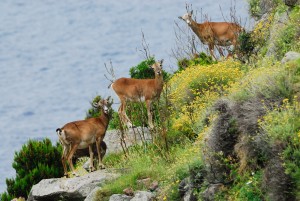 Common name: Mouflon
Common name: Mouflon
Scientific name: Ovis aries
Brief description: This is a bovid similar to the sheep, but its coat has short, non-fuzzy fur. The colour of young males and females is light reddish-brown in the upper part and white on the belly; adult males may have a white patch on the back, similar to a saddle. Males are differentiated from females by their large curved horns which increase in size with age.
Biology and ecology: It is a voracious herbivore with a very varied diet. It prefers habitats with vegetation consisting of holm oaks and cork trees, but it also frequents chestnut woods, mixed woods, and Mediterranean bush. In general, although a native of dry, rocky Mediterranean mountainous areas, with a prevalence of holm oaks, it adapts well to Apennine and alpine environments.
Distribution in the Tuscan Archipelago and introduction: In the Tuscan Archipelago it is present on the Island of Elba (introduced around the ‘70s in the Municipality of Marciana), the Island of Capraia and the Island of Giglio.
Impact: The mouflon feeds on young seedlings and shoots, and for this reason it damages forest vegetation, crops and gardens.
Management in protected areas: For years the populations on the three islands have been monitored with the aim of following any changes in productivity and minimum amounts.
Since 2007 interventions have been carried out to control the number of the species on the Island of Elba. On the Island of Giglio, an eradication programme is active, recently also shared by other Administrations.




